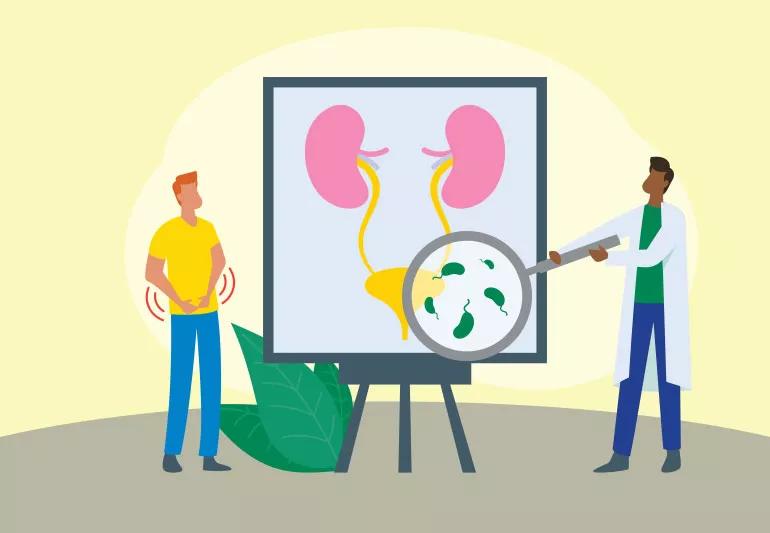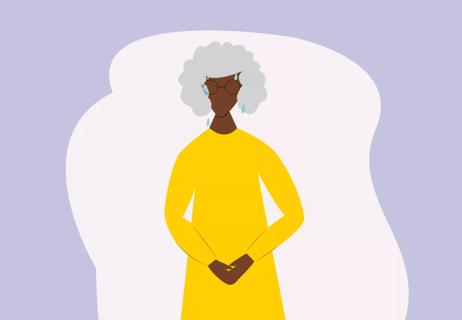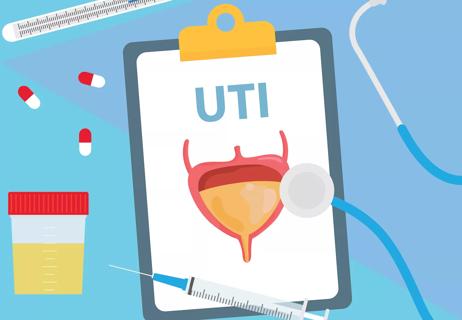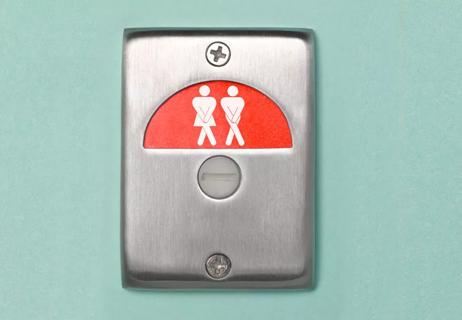A bladder infection is definitely a UTI ... but not all UTIs are bladder infections

Ouch! It hurts to pee! Yet you feel like you have to pee all the time — and, worse still, you can barely squeeze out a trickle when you do.
Advertisement
Cleveland Clinic is a non-profit academic medical center. Advertising on our site helps support our mission. We do not endorse non-Cleveland Clinic products or services. Policy
Yep, it sounds like you have a bladder infection.
Or is it a UTI?
The difference may seem confusing, but mostly, it’s a question of terminology.
Bear with us here: A bladder infection is one type of urinary tract infection (UTI).
But there are other kinds of UTIs, too.
That includes infections in your kidneys, ureters (the tubes that carry pee from your kidneys to your bladder) and your urethra (the tube that connects your bladder to the opening where you pee).
While infections in any part of your urinary tract are properly called UTIs, bladder infections (sometimes called cystitis) are the most common kind.
As a result, people — including healthcare providers — tend to use the words interchangeably, according to urologist Emily Slopnick, MD. “Usually, when we say ‘UTI,’ we mean a bladder infection.”
There’s another reason why people use the terms “UTI” and “bladder infection” interchangeably: The symptoms are largely the same.
If these are the only symptoms you have, the odds are that you have a bladder infection.
Advertisement
But if you have some of these additional symptoms, you may have a different, more serious, type of UTI:
Kidney infections tend to be the most painful, and most serious, type of UTI. If you see blood in your urine and have a fever, get to a healthcare provider as soon as you can.
Bacteria, most commonly Escherichia coli (E. coli), cause UTIs, including bladder infections. These bacteria normally live on our skin and in the areas around the vagina and/or rectum. But sometimes, they get the urge to travel, heading up your urethra and into your bladder. They may even make it all the way up to your kidneys.
Bladder infections are very common, especially in women. In fact, the National Institutes of Health say that 50% to 60% of women will get at least one UTI in their lifetime. But some tend to get them more often than others.
“A lot of the time, we just don’t know why some people are more prone to UTIs than others,” notes Dr. Slopnick. But some factors can add to your chances of getting a UTI:
Your bladder infection is definitely a UTI, although your UTI might not be a bladder infection.
Bladder infections are the most common type of UTI, and research shows that if you get one, you’re likely to get another. But other types of UTIs include:
If you think you might have a UTI, it’s important to see a healthcare provider. A primary care doctor is a good place to start, says Dr. Slopnick, especially if this is the first time you’ve had symptoms. “You only need to see a urologist if you are having recurrent infections.”
As your treatment partner, your healthcare provider will talk to you about your symptoms, which can offer clues as to the severity and location of your infection. They’ll also do a physical exam and order urine tests.
Urine tests are the only way to diagnose a UTI for certain. “Just because you have the symptoms of a UTI doesn’t necessarily mean you have one,” Dr. Slopnick cautions. “There are other causes of bladder irritation, and you don’t truly have a UTI unless the urine culture grows bacteria.”
Advertisement
Your healthcare provider can help figure out the difference and help you get the proper treatment.
Because bacteria cause UTIs, your healthcare provider will prescribe antibiotics to treat them.
Antibiotics are powerful drugs that fight infection. They’re generally safe. But sometimes, they can have side effects, including allergic reactions and serious, possibly life-threatening, diarrhea caused by the bacteria Clostridium difficile (C. diff). Be sure to let your healthcare provider know if you have concerns.
In general, a simple bladder infection isn’t only common, but it’s also easy to treat with oral antibiotics.
But in some cases, additional risk factors can complicate the picture. Factors like abnormal anatomy, a weakened immune system or advanced age can make treatment more difficult. In these cases, you might need to go to the hospital and get intravenous antibiotics (which are delivered through a vein in your arm) to treat the infection.
Left untreated, a bladder infection can become a kidney infection. Kidney infections are a particularly serious type of UTI, and require prompt medical attention. Otherwise, the infection can cause lasting damage to your kidneys, or even spread into your bloodstream.
Advertisement
With treatment, bladder infections usually start to clear up within a few days. But remember: Even if you feel better, take all of your antibiotics. Otherwise, the infection may come back.
Kidney infections — and other “complicated” UTIs — are harder to treat. If you have a complicated UTI, you may require IV antibiotics over a longer time; this will require a hospital stay.
You’ve heard it all before:
Advertisement
Advice for minimizing UTIs sometimes also includes avoiding bubble baths, as bubble bath products may contain ingredients that can irritate your bottom. It seems like common sense. But there really isn’t much science to support it.
While you might not always be able to prevent a UTI, getting treatment early is a smart move. It reduces the risk of bacteria spreading to other parts of your urinary tract. And best of all, you can look forward to feeling better soon.
Learn more about our editorial process.
Advertisement

Cranberry juice and cranberry pills may prevent future UTIs when taken consistently

Yes, but male UTIs are often the result of another issue like diabetes, prostate problems or kidney stones

Only antibiotics will cure a UTI, but home remedies could help prevent future infections

Staying hydrated and peeing after sex can help prevent this common post-sex condition

Signs to look out for include pain and changes in frequency or urgency

Recurrent urinary tract infections are most common in women, seniors

The ins and outs of urinary tract infections

Changes in kidney function and new pressure on your bladder may have you running to the restroom a lot more often

The best parenting style balances enforcing rules and showing plenty of love

Tips include cutting back on sugar, focusing on exercise and managing stress

It can be harder to let go when you’ve invested time, energy and emotions — but it might be the healthier choice long term